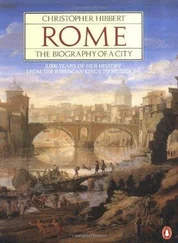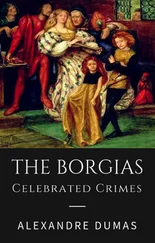The programme for the Carnival pageant, drawn up by humanists employed by the pope and executed by artists working on papal projects in the Vatican, was clearly designed to draw parallels between Caesar and Cesare. And the message would not have been missed by those onlookers who had watched Cesare’s triumphal entry into the city the day before, where they had seen the victorious soldier carrying his own sword, which was engraved with the letters CESAR, and the same letters embroidered on the clothes of his personal bodyguard. Cesare was soon to adopt as his motto ‘ aut Caesar aut nihil ’ — Caesar or nothing — a very ambitious declaration of intent.
‘THE POPE INTENDS TO MAKE THE DUKE VALENTINO A GREAT MAN AND KING OF ITALY IF HE CAN’
‘ON THE MORNING of the fourth Sunday of Lent, 29 March,’ Burchard recorded just a month after Cesare’s triumphant return to Rome as Lord of Imola and Forlì, ‘the cardinals assembled at the accustomed hour in the Sala del Pappagallo and were thence summoned more privately to meet His Holiness in his small audience chamber, where, having taken their advice,’ as the master of ceremonies euphemistically described the process whereby the pope informed the college of his intentions, ‘he decided to bestow the Golden Rose on the illustrious Cesare Borgia, his much-loved son, and to create him Captain-General and Gonfalonier [standard-bearer] of the Holy Roman Church.’
The ceremony had, of course, been planned well in advance. Directly after the meeting, the pope was carried on his throne into St Peter’s, with the Golden Rose in his left hand, followed by Cesare, dressed in a coat of brocade, the cardinals, and other members of the papal court, to join the ambassadors, prelates, and officials assembled in the basilica. Inside Cesare was formally enrobed with the insignia of his new office: the great mantle and the gilded helmet with its ermine plumes crowned by the figure of a dove that glistened with pearls. Kneeling before his father, he made his solemn vows:
I, Cesare Borgia of France, Duke of Valence, Gonfalonier and standard-bearer, Captain-General of the Holy Roman Church, do solemnly swear from this day forwards that I will faithfully submit to St Peter, to the Holy Roman Church and to you, my most holy lord, Pope Alexander VI, and to your canonical successors. Never will I intend, plan or undertake to deprive you of life or limb, to take possession of your person in a wicked fashion, to lay my hands violently on you or your successors, whatever is done against me, whatever wrongs are propagated against me and under whatever pretext, and I will reveal to no one the plans that you or your successors confide in me.
‘Receive these standards,’ Alexander VI responded, giving his son the banners of the church, ‘which have been sanctified by the blessing of Heaven, and will be terrible to the enemies of Christendom.’ He then handed to his son the baton of command and finally the Golden Rose. At the end of the ceremony, the banners were hoisted by two men-at-arms, and the congregation followed them out of the basilica and into the piazza: the ambassadors, eight flautists, four drummers, three heralds, soldiers, cardinals, and finally the duke himself, followed by the footmen and prelates and by Cesare’s men, ‘who marched,’ to Burchard’s obvious distress, ‘in inevitable disorder.’
The proud Cesare could now add the pontifical keys of St Peter to the Borgia bull and the lilies of France on his coat-of-arms, but his ambitions to enlarge his modest state in the Romagna, which depended heavily on the support of Louis XII, had, for the moment, stalled. After the euphoria, which was noticed in his behaviour at this time, he fell into one of those moods of deep gloom, symptoms of the manic-depressive. ‘I know that in my twenty-sixth year,’ he was quoted as having said, ‘I stand in danger of ending my life in arms and by arms.’ He also asked the German humanist Lorenz Behaim to cast his horoscope; and it seems that the result was not encouraging.
Ludovico Sforza’s campaign to seize his duchy back from the French had met with surprising success. He had succeeded in reconquering Milan, although the great Sforza castle remained in French hands, and on February 6 he had made his triumphant return, welcomed by his subjects with much joy. The French army had withdrawn to Novara, awaiting their chance to retake the city, Yves d’Alègre and his gunners, which Cesare needed for his Romagna campaign, among them. There was, however, much that the pope and his son could do to plan the next stage of their campaign, and much money to be raised to finance it.
The year 1500 was a Jubilee year in Rome, when thousands of pilgrims were expected to flock to the city, where, by visiting certain churches, fasting, praying, attending confession and Communion, and giving alms, they would receive pardon for all their sins. The tradition of the Christian Jubilee year was not an ancient one; founded by Pope Boniface XIII in 1300, as a means of raising funds to fill the papal coffers, it had initially been intended as a celebration for the beginning of each century, though Paul II had decreed in 1470 that it should be held every twenty-five years.
Burchard gives a lengthy account of the preparations made in the city for the Jubilee; provision for housing the pilgrims, sweepers to clear the litter from church floors, special patrols to prevent tramps loitering around the porches, and ‘large strong casks,’ added Burchard, ‘were to be provided for freewill offerings next to the Chapel of St Andrew in St Peter’s, and they were to be protected with three different locks and keys, one key to be kept by the Datary, a second by one of the confessors and the third in another official’s hand.’
In an attempt to attract more pilgrims than usual, Alexander VI announced that for the 1500 Jubilee, the Holy Door of St Peter’s would be reopened. This door, which had long been walled up, was by tradition the Golden Gate of Jerusalem, through which Christ himself had entered the city on Palm Sunday. It had reputedly been brought to Rome by Emperor Vespasian after the Roman conquest of the Jewish capital in 70 A.D., and it was widely believed that any sinner who walked through it, even a murderer, would have his sins forgiven.
Accordingly, on December 24, 1499, huge crowds assembled in the piazza in front of St Peter’s to watch the ceremonial opening of the Holy Door. The pope arrived amid much fanfare and celebration, and, according to Burchard, he was ‘handed an ordinary workman’s hammer’ by one of the builders, who had spent several days chiselling away at the Holy Door from inside the basilica to weaken it. The pope ‘gave three or more blows’ to the wall, thus creating a small opening, before retiring to his papal chair a few yards away to watch the workmen demolishing the rest. ‘On this task they spent half an hour, during which time our choir sang continually,’ the master of ceremonies reported.
Alexander VI, dressed in full pontifical robes and wearing the triple tiara, led the ceremonial procession through the Holy Door into St Peter’s, holding a candle in his left hand and Burchard’s colleague supporting his right elbow, followed by the cardinals and the papal court (the builders themselves had been forbidden, ‘under penalty of losing their heads,’ to go through the doorway while they were demolishing it).
The expected influx of pilgrims did indeed materialize, and so did their offerings. The Florentine diarist Luca Landucci reported large numbers of northerners, many from across the Alps, passing through the city on their way south to the Jubilee. From their lodgings in one of Rome’s many inns and taverns or, more cheaply, in the hospices that all Christian nations maintained in the city, the pilgrims thronged the streets of the capital of their faith as they walked from church to church, seeing and believing in the sights and sites of Christian legend.
Читать дальше











